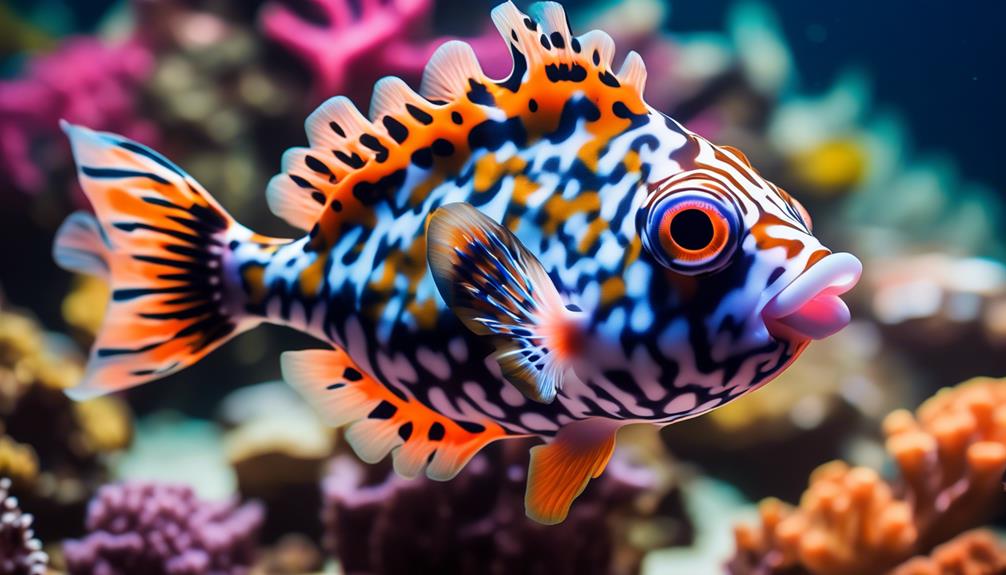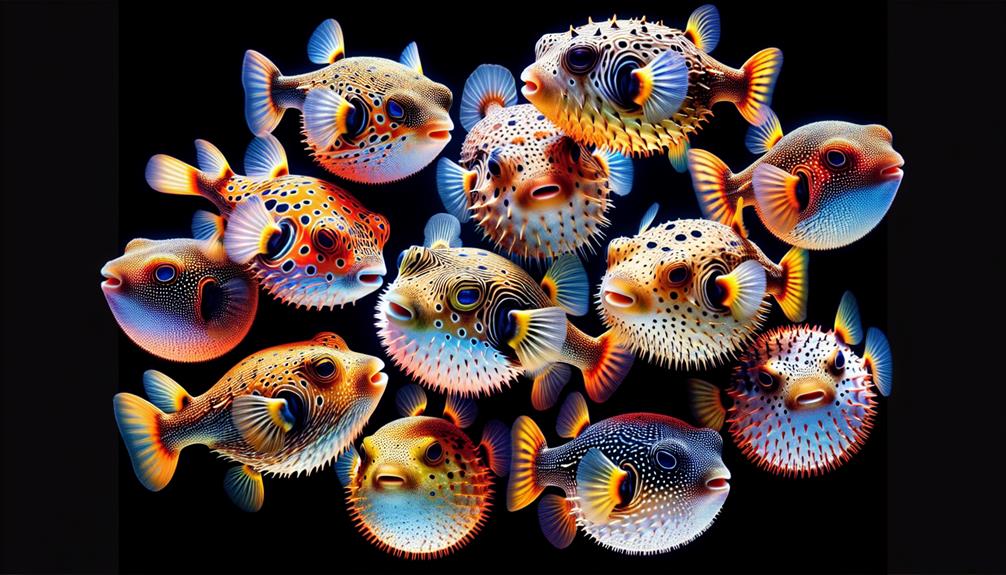Pufferfish species have long fascinated aquarium enthusiasts with their unique and captivating traits. These incredible creatures offer a diverse range of options for those looking to add a touch of intrigue to their aquatic display. From the Nano Puffer, a pint-sized marvel, to the Mbu Puffer, a true giant of the freshwater world, there is a pufferfish species to suit every aquarium setup.
Each species possesses its own distinct characteristics and requirements, making them all the more intriguing. However, it is essential to be aware of their specific care needs and tank environment to ensure their well-being.
In this article, we will explore the fascinating world of pufferfish species, delving into their natural habitats, behavior, and dietary preferences. By understanding the unique traits of each species, you can make an informed decision when selecting the perfect pufferfish for your aquarium.
Key Takeaways
- Nano Puffer (Dwarf or Pea Puffer) is the smallest pufferfish and can be kept alone or in small groups.
- Community Puffers (Amazon or South American Puffer) have a calm temperament and can be kept with similar-sized, active fish.
- Ambush Puffers (Arrowhead or Pig-Face Puffer) are true ambush predators and require plenty of cover and hiding spots.
- Brackish Puffers (Green Spotted Puffer) thrive in brackish water conditions and require ample swimming space.
Nano Puffer (Dwarf or Pea Puffer)
The Nano Puffer, also known as the Dwarf or Pea Puffer, is the smallest pufferfish species in the world. This tiny fish is native to southwestern India and is a popular choice for aquarium enthusiasts due to its vibrant colors and unique characteristics.
Nano puffers can be kept alone or in small groups, but it's important to note that they can be territorial and may exhibit aggressive behavior towards other tank mates. Therefore, it is recommended to keep them with similar-sized, peaceful fish such as small tetras or rasboras.
In terms of diet, nano puffers are carnivorous and feed on a variety of live and frozen foods. A diet consisting of small snails, bloodworms, and brine shrimp is ideal to keep them healthy and thriving in the aquarium.
Community Puffers (Amazon or South American Puffer)
The Community Puffer, also known as the Amazon or South American Puffer, is a captivating species found in the Amazon basin that appeals to aquarium enthusiasts for its hardy nature and ability to tolerate a range of water conditions. This puffer has a calm temperament but may nip fins, so it is important to choose compatible tank mates.
Here are some key considerations when keeping Community Puffers in a community aquarium:
- Compatibility with other fish: Community Puffers can be kept with similar-sized, active fish that are not prone to fin nipping. It is best to avoid slow-moving or long-finned fish that may be targeted by the puffer.
- Water parameters for community puffers: These puffers can tolerate a wide range of water conditions, but they prefer slightly acidic to neutral pH (6.5-7.5) and a temperature range of 75-82°F. Regular water changes and monitoring of water parameters are important for their overall health and well-being.
- Dental care: Community Puffers have continuously growing teeth, so it is essential to provide them with a diet that helps wear down their teeth naturally. Including hard-shelled food items like snails or crustaceans will aid in maintaining their dental health.
- Tank setup: Provide plenty of hiding spots and vegetation for the puffer to explore and retreat to. This will help create a stress-free environment and prevent territorial behavior.
- Feeding: These puffers are omnivorous and can be fed a varied diet consisting of high-quality pellets, frozen foods, and live foods like small snails and insects. Offering a diverse diet will help ensure their nutritional needs are met.
Ambush Puffers (Arrowhead or Pig-Face Puffer)

After exploring the fascinating nature of Community Puffers in a community aquarium, our attention now turns to the intriguing world of Ambush Puffers, specifically the Arrowhead or Pig-Face Puffer.
Ambush Puffers are true ambush predators, known for their unique feeding habits. These puffers are active during mealtimes, patiently waiting for their prey to swim by before striking with lightning speed.
To create the ideal tank environment for Arrowhead Puffers, it is important to provide plenty of cover and hiding spots. These puffers prefer a suitable-sized tank where they can roam freely and exhibit natural behavior.
In terms of diet, Arrowhead Puffers feed on live and frozen foods, such as small fish and crustaceans. They require a well-balanced diet to maintain optimal health.
Ambush Puffers (Hairy Puffer)
The Hairy Puffer, a member of the Ambush Puffers species, exhibits a distinctive 'hairy' appearance that sets it apart from other pufferfish species. This unique feature, along with its intriguing behavior, makes it a fascinating addition to any aquarium.
When it comes to tank requirements, the Hairy Puffer requires a tank with strong current to mimic its natural habitat. It is important to provide plenty of cover and hiding spots to create a comfortable environment for this species.
In terms of feeding habits, the Hairy Puffer is a carnivorous predator that feeds on live and frozen foods. It is necessary to offer a varied diet that includes small fish, shrimp, and other meaty foods.
Taking these factors into consideration will help ensure the well-being of the Hairy Puffer in your aquarium.
Ambush Puffers (Dragon or Humpback Puffer)

Characterized by their larger size and unique physical features, including a humpback-like appearance, the Dragon or Humpback Puffer is an intriguing species of Ambush Puffer that captivates aquarium enthusiasts. These pufferfish can grow up to 8 inches in length, making them a striking addition to a spacious tank. To create a suitable habitat for the Dragon or Humpback Puffer, it is important to provide unique tank setups that cater to their needs. This includes plenty of hiding spots and cover to mimic their natural environment where they ambush prey. When it comes to tank mates, it is crucial to choose other large, compatible fish that can tolerate the puffer's occasional aggressive behavior. The Dragon or Humpback Puffer feeds on a variety of foods, including live and frozen options, ensuring that their dietary needs are met.
| Unique Tank Setups | Compatible Tank Mates |
|---|---|
| Plenty of hiding spots and cover | Other large, compatible fish |
| Mimic their natural environment | Can tolerate occasional aggression |
Frequently Asked Questions
What Is the Ideal Tank Size for a Nano Puffer (Dwarf or Pea Puffer)?
The ideal tank size for a nano puffer (dwarf or pea puffer) is at least 5 gallons. They require a well-maintained tank with live or frozen foods, suitable hiding spots, and minimal tank mates to ensure their territorial nature is respected.
Can Community Puffers (Amazon or South American Puffer) Be Kept With Small, Peaceful Fish Like Tetras or Guppies?
Community puffers, such as the Amazon or South American puffer, can be kept with small, peaceful fish like tetras or guppies. However, compatibility depends on tank size, water conditions, and the individual temperament of the pufferfish.
How Often Should I Feed an Ambush Puffer (Hairy Puffer)?
The feeding frequency for an ambush puffer (hairy puffer) should be two to three times a day, offering a mix of live and frozen foods. As for nano puffers, potential tank mates include small, peaceful fish like tetras or guppies.
Do Ambush Puffers (Dragon or Humpback Puffer) Require Any Specific Water Conditions or Parameters?
Ambush puffers, such as the dragon or humpback puffer, thrive in spacious tanks with strong currents. They can coexist with other large, compatible fish and require ideal water conditions to ensure their well-being.
Are Brackish Puffers (Figure Eight Puffer) Suitable for Beginners or Do They Require More Advanced Care?
Beginner friendly brackish puffers, such as the figure eight puffer, require proper care to thrive. While they can adapt to brackish water conditions, they still need a tank with plenty of swimming space and a diet consisting of a mix of live and frozen foods.
Conclusion
In conclusion, the world of pufferfish species offers a fascinating array of options for aquarium enthusiasts. Each species possesses unique characteristics and requirements, making it important to carefully select the right pufferfish for your aquarium setup.
By understanding their natural habitats, behavior, and dietary preferences, aquarists can create a suitable environment for these incredible creatures. Just like the diverse patterns and tactics of pufferfish, the choices available to aquarium enthusiasts are plentiful and captivating.

